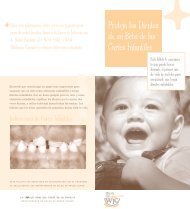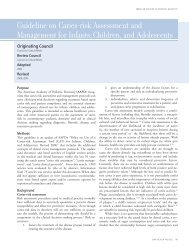Digital Radiography - National Network for Oral Health Access
Digital Radiography - National Network for Oral Health Access
Digital Radiography - National Network for Oral Health Access
You also want an ePaper? Increase the reach of your titles
YUMPU automatically turns print PDFs into web optimized ePapers that Google loves.
<strong>Digital</strong> <strong>Radiography</strong><br />
2006 <strong>National</strong> Primary <strong>Oral</strong> <strong>Health</strong><br />
Care Conference<br />
Robert A. Cederberg, MA, DDS<br />
December 10 – 14, 2006<br />
Scottsdale, Arizona
Development of Dental<br />
<strong>Digital</strong> <strong>Radiography</strong><br />
Background, history and development of<br />
dental digital radiography<br />
Evolution of the technology & systems<br />
Conversion from film to digital and options<br />
<strong>for</strong> the office or clinic<br />
Advantages and disadvantages<br />
Applications and functions<br />
Adjunctive techniques
Background<br />
The development of computed axial<br />
tomography (CAT) in 1972 and<br />
subsequent advances in digital sensors<br />
allowed <strong>for</strong> dental applications.
History of <strong>Digital</strong> in Dentistry<br />
Trophy Radiologie introduced the RVG in 1982<br />
Sensor - CCD (charged-coupled device) with<br />
phosphor screen, active area 17mm x 26mm
Design and Development<br />
First sensors where designed with CCD<br />
chip layered with a phosphor screen, latter<br />
sensors were developed which were direct<br />
exposure.
<strong>Digital</strong> System Components<br />
<strong>Digital</strong> imaging requires a sensor (detector),<br />
analog to digital converter (A/D converter),<br />
computer or CPU, monitor, printer. Additionally,<br />
modem or other (cable, T1, DSL) connection <strong>for</strong><br />
Teleradiograhpy is important.
Steps in <strong>Digital</strong> Acquisition<br />
Electromagnetic energy in the <strong>for</strong>m of x-ray<br />
photons strike the detector (CCD electrical<br />
charge stored in pixels), (PSP latent image<br />
<strong>for</strong>mation)<br />
A/D converter converts the electrical charge into<br />
a digital <strong>for</strong>mat (PSP visible light intensities<br />
converted to digital <strong>for</strong>mat)<br />
A number is assigned to each voltage output<br />
ranging from 0 to 256 (2 8 ) or 256 shades of gray in<br />
the image<br />
Once image is acquired and stored – post<br />
processing, i.e. image manipulation
Enhancements<br />
1987 - Direct exposure CCDs<br />
Early 90’s – Photostimuable Phosphor<br />
(PSP) technology<br />
Early 90’s – Complementary Metal Oxide<br />
Semiconductor (CMOS)<br />
Flat Panel Detectors – CBCT (Cone Beam<br />
Computed Tomography)<br />
Late 90’s – software improvements,<br />
monitor fidelity improvements.
Evolution of Dental X-ray<br />
Image Receptors<br />
Discovery of x rays in 1895, first image<br />
receptors were glass plates.<br />
1900 – celluloid film<br />
1919 – single emulsion dental film packets<br />
1924 – double emulsion dental film<br />
1940 – Ultraspeed film – D speed<br />
1980 – Ektaspeed film – E speed<br />
1982 – first intraoral digital sensor
Direct <strong>Digital</strong> <strong>Radiography</strong>
Basic <strong>Digital</strong> System<br />
X-ray source<br />
Components<br />
Sensor or detector (CCD, CMOS and<br />
storage phosphor)<br />
Computer or CPU<br />
Modem<br />
Printer
Sensors<br />
CCD (Charged Couple Device): silicon<br />
chip with an embedded electronic circuit.<br />
PSP (Photostimuable Storage Phosphor):<br />
plastic plate coated with a photostimuable<br />
phosphor layer.<br />
CMOS-APS (Complementary Metal Oxide<br />
Semiconductor - Active Pixel Sensor):<br />
silicon chip with an ADC <strong>for</strong> each column<br />
of pixels.
Optime PSP plates<br />
Sizes 0, 1and 2<br />
<strong>Digital</strong> Sensors<br />
Trophy Sensor<br />
Size 2<br />
Schick Sensors<br />
Sizes 0, 1 and 2
The Physics of CCD Sensors
Available Sensors
CMOS Sensor
The Physics of PSP Sensors
Conversion from Film to<br />
<strong>Digital</strong><br />
Probably easiest to slowly transition into<br />
digital.<br />
Probably best to consider utilizing more<br />
than one digital system since no one<br />
system will satisfy all of the imaging<br />
needs within one office or clinic, i.e. <strong>for</strong><br />
intraoral imaging, both a PSP and CCD<br />
combination.
Conversion from Film to<br />
Work flow study<br />
<strong>Digital</strong>
Conversion from Film to<br />
<strong>Digital</strong><br />
Main advantage – no darkroom needed<br />
Elimination of the mess of darkroom<br />
chemistry, cost and maintenance of film<br />
processors<br />
Many cities and local municipalities now<br />
regulate waste water discharge and<br />
require silver collectors to be installed on<br />
processors which adds additional mess as<br />
well as expense
Techniques and<br />
Systems<br />
Techniques vary only by the type of detector<br />
used: either CCD or Storage Phosphor<br />
All systems offer the ability to manipulate the<br />
image: i.e. image enhancement, colorization, etc.
Intraoral CCD Based<br />
Systems<br />
Product Name Company<br />
CDR Schick<br />
CygnusRay MPS Cygnus Technologies<br />
Dexis ProVision Dental Systems<br />
Dixi®2 Planmeca Group<br />
Dixsy Villa Sistemi Medicali<br />
FI iOX megapixel Fimet<br />
MPDx Remedent N.V.
Intraoral CCD Based<br />
Systems<br />
Product Name Company<br />
SIDEXIS Sirona<br />
SIGMA PaloDex Group<br />
SuniRay TM Suni Medical Imaging<br />
RVG Trophy<br />
VistaRay DÜrr Dental<br />
VisualiX USB Gendex
Intraoral PSP Systems<br />
Product Name Company<br />
Panorama Xi Orex<br />
Combi-Xi Orex<br />
DenOptix Gendex - Dentsply<br />
Digora Optime PaloDex Group<br />
VistaScan DÜrr Dental<br />
VistaScan Intra DÜrr Dental
Panoramic CCD Based<br />
Systems<br />
Product Name Company<br />
CDRPan Schick<br />
Digipan Trophy<br />
Dimax2, Proline, Promax Planmeca Group<br />
DXIS® Signet<br />
Orthopantomograph OP100D PaloDex Group<br />
Orthoceph OC100D PaloDex Group<br />
ORTHOPHOS DS Sirona
Panoramic CCD Based<br />
Systems<br />
Product Name Company<br />
Cranex Base X D PaloDex Group<br />
Cranex Excel D PaloDex Group<br />
Scanora D PaloDex Group<br />
Orthoralix 9200 (DDE, DPI) Gendex - Dentsply<br />
Versaview (5D, SDCP) Morita
Panoramic PSP Based<br />
Systems<br />
Product Name Company<br />
Combi-Xi Orex<br />
DenOptix Gendex - Dentsply<br />
DenOptix Ceph Gendex - Dentsply<br />
DEXpan Pro Vision Dental<br />
Digora PCT PaloDex Group<br />
Paxorama Xi Orex<br />
VistaScan DÜrr Dental
<strong>Digital</strong><br />
Image<br />
<strong>Digital</strong> X-ray Image?<br />
182<br />
177<br />
180<br />
207<br />
152<br />
175<br />
141<br />
179<br />
51 173<br />
169 52<br />
165 111<br />
130 69<br />
Physical<br />
Definition<br />
Mathematical<br />
Definition
PIXEL<br />
The matrix element of a digital array which identifies a gray<br />
level at that point. It can be processed and manipulated,<br />
usually expressed in 0-255 values.<br />
Gray Scale<br />
O = Black<br />
255 = White<br />
O 255
<strong>Digital</strong> Imaging: Advantages<br />
Image enhancement and analysis - may increase<br />
diagnostic validity of x-rays of non-optimal<br />
density.<br />
No-processing problems - darkroom, processor<br />
and processing chemistry not required<br />
(environmentally friendly).<br />
Less exposure errors - density and contrast<br />
enhancement.<br />
Allows <strong>for</strong> quantitative evaluation.<br />
Lower absorbed doses - 20 to 90% compared to<br />
D-speed film.<br />
Better patient communication and time saver.
<strong>Digital</strong> Imaging: Disadvantages<br />
High cost (Processor/sensor, CPU, monitor,<br />
printer) - CCD and CMOS sensors – 5 to $7,000<br />
Inflexible cassette <strong>for</strong> CCD and CMOS sensor -<br />
may not allow proper placement in all intraoral<br />
locations.<br />
Spatial Resolution not as good as film - film 16 to<br />
20 lp/mm, digital 7 - 13 lp/mm.<br />
Printed copy not as good as screen - resolution is<br />
lost when image is printed.<br />
Not standardized - proprietary hardware and<br />
software.<br />
Learning curve <strong>for</strong> staff.
PaloDex Group Soredex:<br />
Optime
Taking The Radiograph<br />
Place onto<br />
positioning device<br />
Use your current xray<br />
equipment<br />
Take x-ray with<br />
reduced exposure
Digora Optime Hardware<br />
Imaging Plate Processing
<strong>Digital</strong> Imaging<br />
Software Features<br />
Zoom<br />
Contrast/Brightness<br />
Pseudocolor<br />
Rotation<br />
Annotation<br />
Filters<br />
3D<br />
Analysis (Line, Angle)<br />
Manipulating implant<br />
Video Inversion
Negative Conversion
Pseudo-Colorization
3D Function
Measuring Distance and<br />
Angle
Applications<br />
Patient Education<br />
Quantifying the image<br />
Implant planning<br />
Teleradiography<br />
Other
Patient Education
Quantifying the Image<br />
All systems provide the ability to measure<br />
lengths and angles and to analyze the<br />
density gradients throughout the image.
Implant Planning<br />
Some systems provide <strong>for</strong> implant<br />
overlays which are helpful in assessing<br />
potential implant sites.
Teleradiography<br />
Transmission of digital images to remote<br />
sites is a major driving <strong>for</strong>ce in the<br />
evolution of digital radiography.<br />
Remote consultation, Insurance approval.
DenOptix QST
<strong>Digital</strong> X-ray Imaging<br />
100% re-usable<br />
Same size as film<br />
Flexible<br />
Thin<br />
No wires like CCD<br />
sensor<br />
Use with existing<br />
x-ray equipment<br />
Plates
Preparing the plates<br />
To prevent cross<br />
contamination, the<br />
plates are placed in a<br />
disposable plastic<br />
barrier
Preparing the plates<br />
Panometric and<br />
Cephalometric<br />
are placed in the<br />
cassette with<br />
screens
Taking an x-ray<br />
Tear the barriers<br />
and drop the<br />
imaging plate into<br />
the dark box<br />
Be careful of light<br />
exposure and<br />
contamination
The DenOptix Scanner<br />
Scans all image plate<br />
sizes<br />
Integrates with<br />
practice management<br />
software<br />
Simple to learn<br />
No patient discom<strong>for</strong>t
Scanning<br />
In a semi-darkened<br />
area<br />
� Load the plate on the<br />
carousel (can hold up<br />
to 29 plates)<br />
� Attach the pan/ceph<br />
plates
Scanning<br />
Place the loaded carousel<br />
into the scanner<br />
Close the lid<br />
Begin scanning<br />
� 1 min 12 secs <strong>for</strong> up to 8<br />
I/O<br />
� 2 min 30 secs <strong>for</strong> a Pan<br />
� 3 min 30 secs <strong>for</strong> a<br />
Ceph
Sensor - CCD or CMOS<br />
GX-S<br />
RFG<br />
CDR (Schick)<br />
Sidexis<br />
Dixi (Planmeca)
DC Intraoral Unit
Panoramic<br />
Unit
The source of x-rays,<br />
the tube…<br />
Must have<br />
� Smallest focal<br />
point<br />
� AC - DC<br />
� Range of Kv,<br />
mA adapted<br />
to dental xrays<br />
(digital or<br />
not)
The detector<br />
Film, sensor, imaging plates<br />
Image quality parameters are:<br />
� Quantum Mottle Noise (signal/noise<br />
ratio)<br />
� Resolution<br />
� Sensitivity or dynamic range<br />
All three are important!!
Signal/Noise Ratio<br />
Depends on the amount of photons that<br />
strike the image sensor<br />
Noise level: PSP < film < CCD<br />
Images with lots of noise are described<br />
as “grainy”
Resolution<br />
X-ray photon detection takes place in<br />
layers vs on a surface<br />
Resolution is limited by the thickness of<br />
the layer, not pixel size<br />
� Measured by line pairs resolved per mm<br />
(lp/mm)<br />
� Limited by what the eye can detect<br />
� Film = 20 lp/mm<br />
� PSP = 7 - 14 lp/mm (I/O)<br />
� Sensor = 10 - 24 lp/mm (I/O)<br />
Diagnostic resolution is the key.
Resolution<br />
600 dpi 300 dpi
A good image means…<br />
Good x-ray source<br />
� Small focal spot, collimator, x-ray beam<br />
quality<br />
Good positioning<br />
Good detector
RINN Sensor Holder
Dexis Sensor
Comparison of Image<br />
Receptor Characteristics<br />
Contrast resolution<br />
Spatial resolution<br />
Sensor/receptor latitude<br />
Sensor/receptor sensitivity<br />
MTF, SNR (NEQ and DQE)<br />
Contrast and spatial resolution of the<br />
human eye
Contrast Resolution<br />
The ability to distinguish different densities<br />
in the radiographic image.<br />
Factors affecting contrast resolution:<br />
1. Attenuation characteristics of the tissues<br />
being imaged.<br />
2. Sensor bit depth and noise level.<br />
3. Monitor resolution, bit depth, dot pitch,<br />
luminance and display size.<br />
4. Ambient lighting.
Contrast Resolution<br />
<strong>Digital</strong> imaging systems are capable of<br />
capturing up to 256 different densities,<br />
monitors/operating systems are only<br />
capable of displaying 242 different<br />
densities.<br />
The human eye can only distinguish 32<br />
different densities.
Spatial Resolution<br />
The capacity of the image to display fine detail.<br />
*The theoretical limit of resolution is a<br />
function of the pixel size of the system.*<br />
Image receptor pixel sizes: film – 8 microns,<br />
high res. CCD – 20 microns, PSP – 40 microns.<br />
Resolution: film = > 20 lp/mm, CCD = 25 lp/mm<br />
(theoretical with software enhancements), PSP<br />
= 12.5 lp/mm.
Sensor Latitude<br />
The ability of the sensor to capture a range<br />
of x-ray exposures.<br />
A desirable quality of a sensor/receptor is<br />
the ability to display a full range of<br />
densities.<br />
Dynamic range of film extends to 4 orders<br />
of magnitude (with hot lighting),<br />
CCD/CMOS sensors extend to 2 orders of<br />
magnitude and PSP sensors extend to 5<br />
orders of magnitude of x-ray exposure.
Sensor Sensitivity<br />
Sensitivity of a sensor is its ability to<br />
respond to small amounts of radiation.<br />
Sensitivity of film is directly related to film<br />
speed.<br />
Sensitivity of digital sensors affected by<br />
pixel size and system noise.<br />
PSP systems allow dose reductions of<br />
about 50% compared to F-speed film.<br />
CCD/CMOS less dose reduction than PSP.
Modulation Transfer<br />
Function (MTF)<br />
MTF is a measure of the combined effects of<br />
sharpness and resolution.<br />
The MTF of E-speed film is superior to the<br />
MTF of PSP at high spatial frequencies.<br />
The 50% modulation level <strong>for</strong> PSP is<br />
reached at 2.5 lp/mm whereas E-speed<br />
film is not reached until 10 lp/mm.
Signal-to-Noise Ratio<br />
(SNR) – NEQ and DQE<br />
The ratio of the signal amplitude to the standard<br />
deviation of the fluctuations in noise.<br />
NEQ – noise equivalent quanta<br />
DQE – detective quantum efficiency<br />
At low spatial frequencies PSP systems have<br />
superior NEQ to E-speed film across the<br />
exposure range. Data suggested that a PSP<br />
sensors are able to absorb more quanta<br />
(photons) per unit area as compared to film.
Signal-to-Noise Ratio<br />
(SNR) – NEQ and DQE<br />
Higher quantum absorption of PSP leads<br />
to a superior DQE as compared to E-speed<br />
film.<br />
Theoretically higher quantum absorption<br />
and higher DQE of PSP sensors could<br />
provide a more efficient absorption of<br />
photons and thereby an image with<br />
improved definition.
Contrast & Spatial Resolution<br />
of the Human Eye<br />
In terms of contrast, the displayed image<br />
provides up to 8 times the amount of in<strong>for</strong>mation<br />
that the eye can actually see.<br />
The minimum contrast threshold (greatest<br />
perceptual sensitivity) corresponds to a spatial<br />
frequency of approximately 5 lp/cm or about a<br />
1mm wide pixel size. Consequently, the sensor<br />
can display approximately 2.5 times the amount<br />
of in<strong>for</strong>mation that the eye can actually perceive.
Lesion Recognition Research<br />
Studies have looked at both natural<br />
carious lesions and simulated lesions and<br />
tested the resolving power of film vs<br />
digital.<br />
Conclusion – The ability to recognize<br />
incipient caries lesions is NOT dependent<br />
on image receptor (film or digital), the<br />
system used or the manner in which it is<br />
displayed.
References<br />
Brettle DS, Workman A, et al. The imaging per<strong>for</strong>mance of a storage<br />
phosphor system <strong>for</strong> dental radiography, Br. J. Radiol. 69, 256-61<br />
(1996).<br />
Cowen AR, Workman A, Price JS. Physical aspects of photostimuable<br />
phosphor computed radiography, Br. J. Radiol. 66, 332-45 (1993).<br />
Wang J, Langer S. A brief review of human perception factors in digital<br />
displays <strong>for</strong> picture archiving and communications systems, J. Digit.<br />
Imaging. 10(4), 158-68 (1997).<br />
Cederberg RA, Tidwell E, et al. Endodontic working length assessment<br />
comparison of storage phosphor digital imaging and radiographic<br />
film. OOOOE. 85, 325-8 (1998).<br />
Cederberg RA, Frederiksen NL, et al. Influence of the digital image<br />
display monitor on observer per<strong>for</strong>mance. Dentomaxillofac Radiol.<br />
28, 203-7 (1999).
Image Examples<br />
From Planmeca’s website
Planmeca Bite Wing Series – left side
OpTime Bite Wing Series – left side
Planmeca image<br />
OpTime image
Conclusion<br />
Storage phosphor technology provides<br />
film-like sensors which are easier to place<br />
<strong>for</strong> all intraoral imaging sites.<br />
More com<strong>for</strong>table <strong>for</strong> the patient and<br />
placement especially <strong>for</strong> premolar<br />
bitewings allows operator to image the<br />
distal of the canines.<br />
Elapsed time <strong>for</strong> completion of image is<br />
actually less than <strong>for</strong> some hard-wired<br />
systems.
Conclusion<br />
Portable – no need to be tied to a<br />
computer. Can be taken in any operatory<br />
with a tube head and even with a hand<br />
held unit.<br />
Widest dynamic range of any sensor<br />
allows <strong>for</strong> potential recovery of diagnostic<br />
in<strong>for</strong>mation in an otherwise underexposed<br />
image.<br />
Improved DQE theoretically provides<br />
better image clarity & definition.
Conclusion<br />
Some common fallacies concerning the<br />
superiority of film and/or CCD/CMOS<br />
receptors over PSP receptors:<br />
One sensor type will be sufficient <strong>for</strong> all<br />
intraoral imaging applications. Probably<br />
only true <strong>for</strong> film and PSP. Depending on<br />
the type of hard-wired sensor there may<br />
difficulty obtaining certain images such as<br />
molar periapicals and premolar bitewings.
Conclusion<br />
Some common fallacies concerning the<br />
superiority of film and/or CCD/CMOS<br />
receptors over PSP receptors:<br />
CCD/CMOS systems claims of superior<br />
resolutions of 25 lp/mm or greater as<br />
compared to PSP. The human eye has the<br />
best acuity at pixel sizes approximating<br />
1 mm, 2.5 times the resolving power of<br />
most PSP systems. Is it enough to detect<br />
decay? Yes! But, image clarity is more<br />
important.
<strong>Digital</strong> Subtraction<br />
<strong>Radiography</strong>
Cone Beam CT
Flat Panel Detector<br />
Amorphous Silicon Flat Panel Detector
Effective Dose Comparison<br />
i-CAT 20 sec scan 68 uSv<br />
i-CAT 10 sec scan 34 uSv<br />
Daily background 8 uSv<br />
Panoramic – film 10-15 uSv<br />
Panoramic – digital 4.7-14.9 uSv<br />
Full Mouth Series – film 150 uSv<br />
Hitachi MercuRay CBCT 485 uSv<br />
Medical CT 1200-3300 uSv
Panoramic
X-Sectional Imaging
Localization
Orthodontics
Pathology
What Does the Future of <strong>Digital</strong><br />
<strong>Radiography</strong> Look Like?<br />
Evolution and development of existing<br />
systems – It’s here to stay!<br />
Further integration of other technologies<br />
into existing systems.<br />
CBCT will become ‘standard of care’ <strong>for</strong> all<br />
dental imaging needs. CBCT will become<br />
more widely used, price will come down.<br />
Perhaps, a CBCT scan and bitewings will<br />
someday be the dental exam standard.











